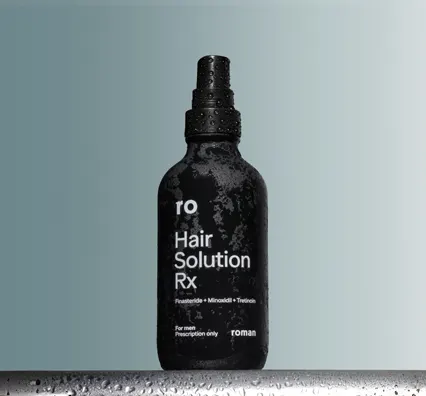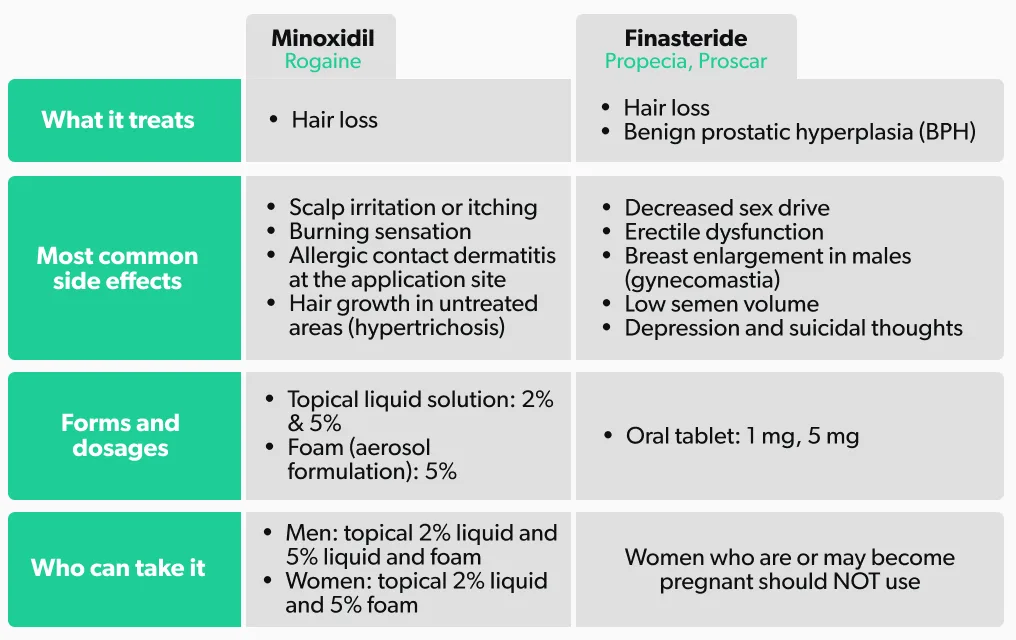Here's what we'll cover
Here's what we'll cover
Here's what we'll cover
If you’re struggling with thinning hair, you’ve probably searched high and low for a solution.
Fortunately, science has provided us with several options to help slow and replenish hair loss. But choosing between hair loss treatments, like finasteride vs. minoxidil, may feel daunting.
Read on to learn more about the similarities and differences between these two popular hair loss medications to determine which one is right for you.

Finasteride vs. minoxidil: what’s the difference?
Finasteride (brand name Propecia) and minoxidil (brand name Rogaine) are medications used to treat male pattern hair loss, or androgenic alopecia, the most common cause of balding (Ho, 2021).
Both of these drugs help slow hair thinning and encourage hair growth. However, they act on the hair follicles in different ways. Finasteride is a prescription pill, while minoxidil is available as an over-the-counter solution or foam. Let’s take a deeper look at Propecia vs. Rogaine.
Finasteride Important Safety Information: Read more about serious warnings and safety info.
Oral Minoxidil Important Safety Information: Read more about serious warnings and safety info.
How does finasteride work?
Finasteride works by stopping the conversion of testosterone to dihydrotestosterone, or DHT.
Studies show that people with male pattern baldness have higher levels of DHT in the scalp. DHT causes miniaturization of the hair follicles, where hairs become thinner and shorter, eventually leading to hair loss. By blocking DHT production, finasteride helps slow hair loss and promotes hair regrowth (Ho, 2021; Zito, 2022).
If you plan on taking finasteride for hair loss, it can take up to 6–12 months to see results. The good news is that finasteride’s effects can last for up to a year after you stop taking the drug (Zito, 2022).
How does minoxidil work?
Minoxidil stimulates hair growth, although the exact way it works is still a mystery.
Scientists know that minoxidil is a vasodilator, a drug that widens blood vessels and increases blood flow. The theory is that by increasing the flow of blood and nutrients in the scalp, minoxidil stimulates hair follicles and promotes hair growth (Badri, 2021).
It may also encourage hair follicles to enter the growth phase of the hair cycle (called the anagen phase) and remain there longer, allowing for longer and thicker hair. You may need approximately eight weeks of treatment before you start to see results, with maximal improvement visible after four months (Badri, 2021).
What forms do finasteride and minoxidil come in?
Finasteride is available by prescription only as an oral pill. The recommended finasteride dosage is typically 1 mg daily when using it for hair loss. However, oral finasteride is also used to treat an enlarged prostate or benign prostatic hyperplasia (BPH). For BPH, it is typically prescribed at a higher dose of 5 mg per day (Zito, 2022).
Minoxidil is available over-the-counter in two topical forms: liquid solution and foam (aerosol formulation). The foam is available in the United States in 5% strength, and the solution comes in 2% and 5% strengths. However, the 5% topical solution is only FDA-approved for men, whereas the 2% topical solution and the 5% topical foam are approved for both men and women (Badri, 2021).
You may also come across information about oral minoxidil.
Studies looking at oral minoxidil for alopecia are highly variable, with doses ranging from 0.25 to 10 mg daily for 6–12 months. While oral minoxidil is not FDA-approved for hair loss, some trials suggest that oral minoxidil could be an effective treatment. However, more research is needed in this area (do Nascimento, 2020).
Side effects of finasteride vs. minoxidil
Like all medications, you need to weigh the hair loss benefits of finasteride and minoxidil against their potential side effects.
Finasteride side effects
Common side effects of finasteride include (Zito, 2022):
Decreased libido or sex drive
Erectile dysfunction
Breast enlargement in males (gynecomastia)
Low semen volume
Depression and suicidal thoughts
Other side effects include (Zito, 2022):
Potential for male fertility issues
Dizziness
Weakness
Shortness of breath
Allergic reactions, like skin rash or itching
Minoxidil side effects
In the first few weeks of using topical minoxidil, it is normal to experience some hair shedding, a condition called telogen effluvium. Fortunately, this effect is temporary, and the shedding stops as you continue to use the medication (Badri, 2021).
Other common side effects of minoxidil include (Badri, 2021):
Scalp irritation or itching
Burning sensation
Allergic contact dermatitis at the application site
Hair growth in untreated areas (hypertrichosis)
Rarely, some people may notice a drop in blood pressure (hypotension).
Can you take finasteride and minoxidil together?
In short, yes. Studies suggest that using finasteride and minoxidil together might be more effective at slowing hair loss and improving hair growth than either therapy alone. But we need more research to determine the best dosages for combination treatment (Chen, 2020).
Finasteride vs. minoxidil: which is better?
So, which hair-loss treatment is the better choice? The answer is that both minoxidil and finasteride are effective.
Very few clinical studies look at head-to-head comparisons of the two medications.
One small study suggested that minoxidil may produce faster results initially in about a third of people. However, this same study concluded that finasteride produced slightly better results with longer treatment duration. But these differences were small. Overall, both are effective, and each has its advantages and disadvantages (Saraswat, 2003).
Ultimately, the hair loss treatment you choose depends on your needs, side effect tolerance, the severity of your hair loss, your sex, and more. Your healthcare provider can help you choose which treatment makes the most sense for you.
Minoxidil vs. finasteride: differences and similarities

DISCLAIMER
If you have any medical questions or concerns, please talk to your healthcare provider. The articles on Health Guide are underpinned by peer-reviewed research and information drawn from medical societies and governmental agencies. However, they are not a substitute for professional medical advice, diagnosis, or treatment.
References
Badri, T., Nessel, T. A., & Kumar, D. D. (2021). Minoxidil. StatPearls. Retrieved on April 25, 2022 from https://www.ncbi.nlm.nih.gov/books/NBK482378/
Chen, L., Zhang, J., Wang, L., et al. (2020). The efficacy and safety of finasteride combined with topical minoxidil for androgenetic alopecia: a systematic review and meta-analysis. Aesthetic Plastic Surgery, 44 (3), 962–970. doi:10.1007/s00266-020-01621-5. Retrieved from https://pubmed.ncbi.nlm.nih.gov/32166351/
do Nascimento, I., Harries, M., Rocha, et al. (2020). Effect of oral minoxidil for alopecia: systematic review. International Journal of Trichology , 12 (4), 147–155. doi:10.4103/ijt.ijt_19_20. Retrieved from https://pubmed.ncbi.nlm.nih.gov/33376283/
Ho, C. H., Sood, T., & Zito, P. M. (2021). Androgenetic alopecia. StatPearls . Retrieved on April 25, 2022 from https://www.ncbi.nlm.nih.gov/books/NBK430924/
Saraswat, A. & Kumar, B. (2003). minoxidil vs finasteride in the treatment of men with androgenetic alopecia. Archives of Dermatology , 139 (9), 1219–1221. doi:10.1001/archderm.139.9.1219-b. Retrieved from https://pubmed.ncbi.nlm.nih.gov/12975174/
Zito, P. M., Bistas, K. G., & Syed, K. (2022). Finasteride. StatPearls Retrieved on April 25, 2022 from https://www.ncbi.nlm.nih.gov/books/NBK513329/











